santamaria
1-6 Feb 2015 – Machu Picchu: A place of peace & power
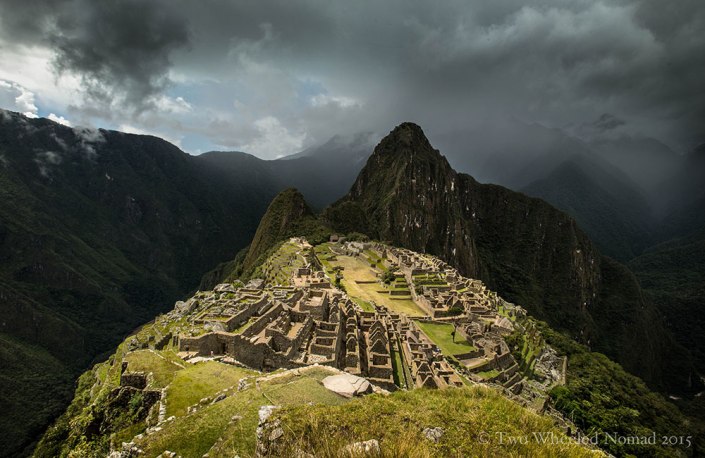
Getting to Machu Picchu under our own steam was a conscious choice that worked fairly well. As opposed to opting for a four-day Jungle Trail package for example, which offered more bang for our buck. $200 US would’ve added in four high-energy activities on top of Machu Picchu but for us, spending our clock and cash riding to and visiting the iconic Inca ruins was paramount. Rushing our way through mountain biking when we bike practically everyday to then trek six hours with the day-trippers, after having hiked some of the best stomping ground in South America, didn’t overly appeal. The river rapids and zip lining would’ve been fun though. Still, this was about Machu Picchu and little else.
Our chosen route towards the great Inca city – so well publicized, documented and captured on film – made me mull over whether actually seeing Machu Picchu for myself might angle towards the anticlimactic, or may be remove some of the mystery surrounding it? I dared to hope that wasn’t going to be the case on the way out of Peru’s Inca capital, Cusco. Admittedly, the price to transport two of us: on two motorcycles, in a taxi, marching our out-of-condition feet on a railway ramble to lodge in a captive-audience area to then catch a bus up to the National Park, cost us several arms and aching legs.
In Peru’s rainy season, my mind soon turned to other matters when the Satnav shaved some mileage off highway 3S, and instead led us down an off road shortcut to Ollantaytambo. Namely, a mess of muddy tracks through a line of lofty hillside alongside River Vilcanota’s milky mocha waters. It wasn’t Dakar-level mud but it was muddy good fun for us. The Garmin saved us a whopping four miles off the journey. Isn’t it always the unexpected interruptions that add colour and texture to your day, or for us brown and wet, soft earth caked all over our bikes and bodies.
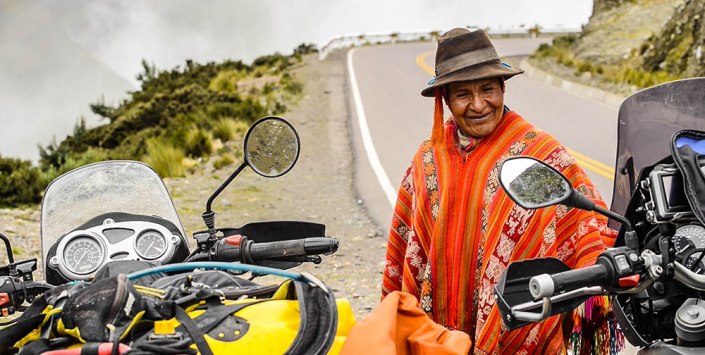
High up in the mountains on the way to Santa Maria, we stopped to take five. High in altitude but low in warmth, it was like a little Switzerland in the wintery Welsh Valleys of South America. But steeped in Inca heritage where wild rugged mountains rose to thousands of metres and in between them were hidden innumerable valleys, tiered full with terraces, streamlets, hiking and biking trails, and high elevation meadows overflowing with sprays of wildflowers, sheep and llamas.
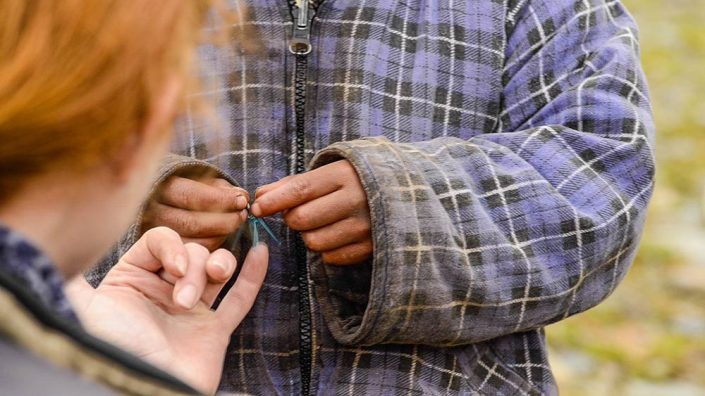
I took a cursory glance and flopped in a tired heap next to my bike, zonked instantaneously while Jason surveyed the scene – cloud-mingled mist climbing up the mountainside like rising smoke. A farmer with his four year old daughter, Elena were curious enough to wander over, while shepherding his sheep with a handmade catapult to roam on the grass, not the road. Like so many children in South America, this little girl had a serenity that lay behind her dark brown eyes. Filthy from matted head to hard-skinned toes, she wore a brightly coloured croqueted bonnet tied beneath her chin, bore the odd rip and tear in her grubby clothing yet her hands and feet were warm to the touch.
Smiling brightly each time I made eye contact, I continued to convey interest in her. She stood on one spot, quietly fascinated by a broken, blue sparkly plastic earring, which held her attention as much as she did mine. Namely, I just wanted some interaction with this cute-as-a-button wee Peruvian. When I rifled through my panniers to produce biscuits and peanuts, Elena beamed when I put them in her mucky hands.
Having spent longer than anticipated on a wet, dirt road to Santa Maria, we followed suit the next morning to Santa Teresa. Ditching the bikes and dumping all but our day packs at Hostel Yacumama, we negotiated a ‘Don’t-take-the-biscuit’ bike fee and jumped in a minibus taxi from Santa Teresa to Hidro Eléctrica, the local Hydro electric power plant. Too frugal to pay the $42 US one-way train fare, we traipsed alongside the railway track for seven odd miles into Aquas Calientes. Jason suffered waives of sickness, doubled over now and again with stomach cramps and endured problems with his constitution, caught out from goodness knows what. He walked as though he was wading through treacle every step of the way. I carried the gear, felt royally unfit for the duration and to add laborious insult to unlucky injury, the afternoon unleashed a torrent of rain. The pair of us made a complete meal out of it.
The juxtaposed tiny town of Aquas Calientes – only accessible by train or on foot – is a jarring mix of ancient and modern. So great was the discord upon entering this sub-tropical jungle spot, we were hit first by the general reek of money – a line of plush hotels and fine jewelry stores – in parallel with a raging river running a fierce course of chocolate milk against lush green, monumentally neck-craning mountainside. The place was thriving on the wads of wonga from the purses and wallets of all and sundry that like us, wanted a spellbinding piece of Machu Picchu’s magic.
The jungle town is renowned to adopt a ‘We’ll never see you again’ mentality and vendors do their utmost to overcharge for every conceivable product and service available. When I began bartering for a café con leche, a cuppa coffee, the lady simply smiled and with a discernibly smug air informed me, “Yes but my milk is very, very fresh”. Mmn, I’ll milk Daisy’s udders myself if it’ll save me three quid. I prayed the Morris powers of persuasion would take effect, went in hard and negotiated down with a “Oh come oooon, you look like a very, very lovely lady who’ll be kind enough to offer a much nicer price”. The impulsive shimmy tagged on at the end seemed to put her slightly off kilter and she reluctantly agreed. Job done.
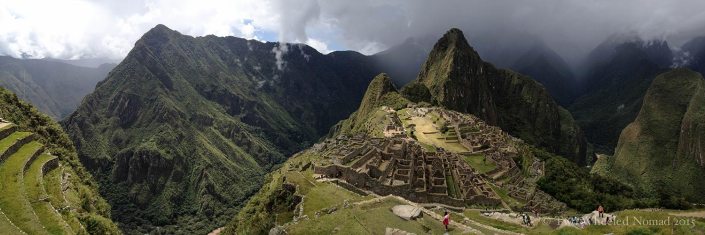
Come the dark, misty light of dawn, our 5.30am bus traversed the sharp switchbacks of the steep Carretera Hiram Bingham, up to Machu Picchu Park. Groggy from the fug of sleep, we alighted the bus and looked upon the gateway to the sacred grounds. Jason raised an eyebrow at me, which would have been pure Spafford had his features not resembled those of a sleep-ruffled ferret.
I stepped beyond the entrance and started on the ancient pathway. A thick belt of clouds and the high morning mist enveloped us, which gave the start of the day a damp, dull cast. Poncho doing its duty in the persisting rain, I tucked into a warm pastry for my 6.10am breakfast on the Inca bridge, while my mind’s eye imagined a totemic vestige of lost civilization – about as dreamlike as my day was likely to get. Reality gave me only Jason’s profile from behind, trundling along in front of me. Poor bloke, he felt as rough as a badger’s backside.
Mid-morning, the mist gave way before us and ragged grey curtains parted by their prow, which bathed the ruins in a soft, flickering light. It didn’t cease to amaze me that our ancestors had built such a triumph. I tried to wrap my comprehension around the number of steps that had been carved out of enormous pieces of rock and carried, piled and tiered to create the wonderment that is Machu Picchu. The sheer size of it filled my soul with a wowed quietness. Fathomlessly unknowable how a few hundred men simply pushed the rocks up inclined planes using stones with knobs on them to lever others into position. For this one still and silent moment of the day, everything in the world was at peace, locked in beauty. Verdant terraces emerged in every shade of green; emerald, olive and thyme. And sage, moss and myrtle. I couldn’t help but let my soul dance, breathing in the miracle of man’s work.

2,453 metres above sea level and nestled on a small hilltop between the Andean Mountain Range, the majestic lost city of the Incas soars above a bow of the rumbling Urubamba river precipitously below. The estate sits in a saddle between the two mountains Machu Picchu and Huayna (Wayna) Picchu, with a commanding view down two valleys and a nearly impassable mountain at its back. Located in semi-tropical highland, the area is known as the ‘eyebrow of the jungle’.
Part of the Vilcabamba Batolite formation, Machu Picchu is part of a mass of igneous rock, 250 million years old. The most common stone found in the region is a greyish-white granite, and because of its high quantities of quartz, mica and feldspar makes it relatively easy to shape. And so the Andean masons proved, who made light work out of utilising such a magnificent building material. Built in 1450, many archaeologists believe that Machu Picchu was constructed as an Incan retreat for the emperor Pachacuti; an estate for him and his royal court, or panaca, to relax, hunt and whimsically entertain guests. Separated into three areas – agricultural, urban, and religious – the Incan built structures were arranged so that the function of the buildings matched the form of their surroundings.
The city in its heyday had a water supply from natural springs on highly developed irrigation systems that couldn’t be blocked easily and aqueducts that took advantage of the natural slopes. Splashing fountains also abounded in its time. Masterpieces of hydraulic engineering brought fresh water into buildings while other channels removed waste. The surrounding hillsides were cultivated with fertile soil terraces, not only to provide more farmland to grow crops, but to steepen the slopes which invaders would have to ascend. Many believe sufficient to feed the population of a guesstimated 1,200 four times over. The terraces also reduced soil erosion and protected against landslides. A time of exulting in a period of collective brilliance, wouldn’t you agree?
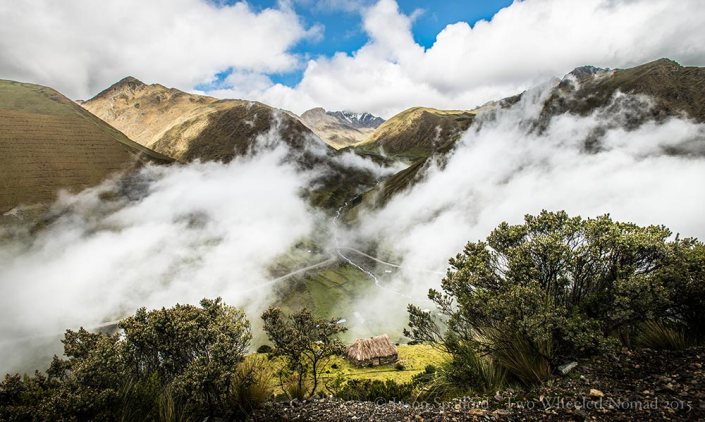
The lower areas contained buildings occupied by farmers and teachers, and the most important religious areas were located at the crest of the hill, overlooking the lush Urubamba Valley a world below. Machu Picchu was utilised by the Inca as a secret ceremonial city with an observatory bound in astronomical and equinoctial importance. The rising and setting of the sun when seen from certain locations within the estate aligns neatly with religiously significant mountains during solstices and equinoxes. All that said, two high-altitude routes from Machu Picchu go across the mountains on the 110 kilometre Inca Trail back to Cusco; one through the sun gate, and the other across the Inca bridge. Both could be blocked easily, should invaders approach along them. Regardless of its original purpose, it’s strategically located and readily defended.
Having paid an additional $10 US in advance, we started up Wayna Picchu’s set of rough-hewn stone steps, the site’s sacred and loftiest peak at 2,693 metres. In Quechua, Wayna Pikchu means ‘young or young man’ and ‘pyramid’. Partway up the northern side is the Temple of the Moon inside a cavern, allegedly a goddess’ cave. Lichen spangled stones dotted over the mountainside, they were steep in parts and the resident morning mist left them slippery. The views from the top of Wayna Picchu gave rise to a further acute and amazing moment, well worth the slog of an ascent. Oddly though, the strongest and probably most profound view of the Inca estate was ascertained when we entered the park, not atop its tallest peak.
Shamanic legends tell that when a sensitive person touches their forehead to Machu Picchu’s Intihuatana stone it opens their vision to the spirit world. I wondered if a similar effect transpired when Jason, still feeling dreadful with diarrhea, lost his footing half way down Wayna Picchu and plummeted 25 feet, grating against its sheer face. Oh my giddy ants, “JASON!”, I shouted as I watched him, his forehead and everything else besides descend through an eternity of jungle bush and trees. My heart seemed to sink right through my body and into the muddy earth.
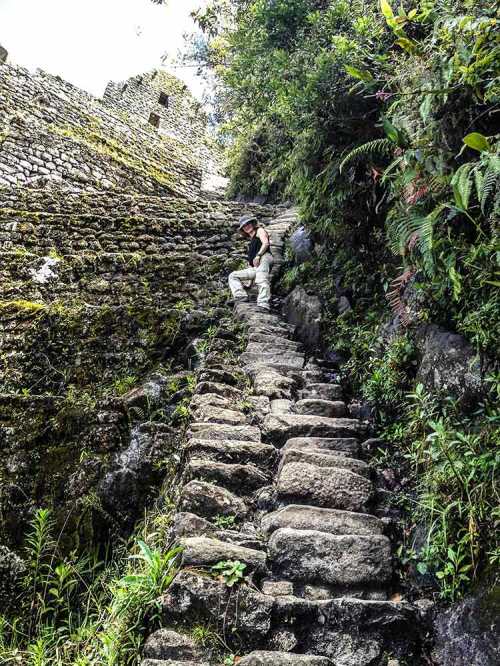
Down a level, there was a chap with his arms outstretched waiting to soften Jason’s landing. It was almost comical when he grabbed a dishevelled Jason on impact, removed his dirtied cap and poured litres of water over his mud smudged head. Drenching him back to a refreshing reality, he enquired with a concerned sincerity, ‘Are you alright?’ More or less but you’ve just washed away his vision into the spirit world. Stunned to the root of my soul, I was in a shaken state of disbelief having witnessed him fall, and consumed with relief that it was onto a lower ledge rather than an abyss over the precipice. Somehow, settling on his jammy feet. Festooned in the mountain’s natural debris but stalwartly in one piece on terra firma, I thanked the Inca deities a thousand times over. Heart hammering at my chest, I cried a cathartic flood but afterwards supposed you should never discount the wonder of your tears. They can be healing waters and a stream of joy. Sometimes, I guess they’re the best words the heart can speak.
In 1874, by order of the Peruvian Government, a German cartographer Herman Gohring mapped the region, employing the names Machu Picchu and Wayna Picchu for the first time in the modern era. Other explorers and locals would in turn find Machu Picchu prior to Hiram Bingham’s famous rediscovery, which brought word of the ruins to the outside world in 1911. Bingham, a North American History professor, came to South America to research the military campaigns of the liberator Simon Bolivar. Having taken an interest in Incan culture, Bingham journeyed to Cusco with a sergeant, his translator.
While travelling through the Sacred Valley of the Incas along the Urubamba River, they stopped at a place in the Hacienda Cutija. There they met a farmer named Melchor Arteaga. Arteaga gave the explorers information about the existence of some ruins at the top of what they cited an ‘Old mountain’ (Machu Picchu) and received a one coin tip for his trouble. When Bingham reached the mountain, he found two families farming its steep sides on the terraces. It was an 11-year old child, the son of one of the families, who led the explorers into the archaeological remains. On 24 July 1911, they glimpsed their first look at the ‘Royal Tomb’, the ‘Principal Temple’, and at last, the ‘Temple of the Three Windows’. Since then, that date is known as the ‘Day of the Scientific Discovery of Machu Picchu’. Interestingly, letters written to Bingham’s son were revealed sometime later by the son divulging how Bingham overdramatised the difficulty of journeying to and the discovery of Machu Picchu, quite sensationally in fact so as to no doubt increase his kudos, heroic status, accredited fame and popularity.
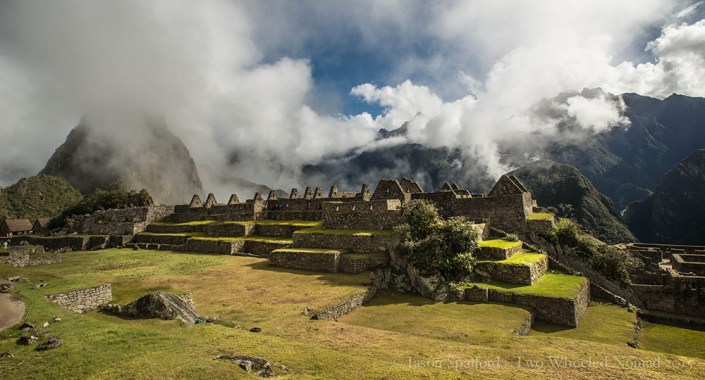
Glancing out from the Funerary Rock Hut on all the temples, patchwork quilt fields, pristine terraces and baths seems to take you to another time. Blending in with the hillside itself, the lost city created a seamless and elegant green paradise, making Machu Picchu a ‘must see’ of Peru for me. Although Jason would urge you to factor in the cost and time to get there as well as the desired duration to experience it. It was one of the most beautiful and enigmatic ancient sites on which I’ve ever locked my eyes. Shrouded in as much legend, myth and sacredness as there was mist and cloud, the site was in a remarkable state of preservation.
The structures, carved from granite of the mountain top are wonders of both architectural and aesthetic genius. Many of the building blocks weigh 50 tonnes or more yet are so precisely sculpted and fitted together with such exactitude that the mortarless joints will not permit the insertion of a piece of paper. It’s perhaps one of the most petite but most revered and extraordinary cities ever visited, invisible from below and completely self-contained.
Wearily, we walked from Machu Picchu back to Aquas Calientes. A long but easy enough descent although Jason still managed to trip up a couple of times. That evening he took a perfunctory shower and peeled into bed; the sounds of gentle snoring soon filled the air. I was lead-weight exhausted, a myriad of emotions having taken their toll. My eyes had a will of their own, they closed and I slipped into a deep and comforting sleep.
The trail we took back along the railway the following morning started stiffly for our worn-out calves. My legs had all but fallen into abeyance. All that was required was an action, a cold start, instant and brutal as beginnings so often are. The seven miles somehow managed to soar inside two hours, it’d taken nearly double that to walk the same on the way there. The air was filled with butterflies, floating like confetti: oranges, yellows, iridescent blues and some fluttering transparent wings while others spanned Jason’s hand. Mindful to such moments, I was thrilled we’d walked and not trained it back.

The dirt road near our hostel had dried and dew sparkled everywhere, diamond-like tears of the early morning reflecting the sun’s warmth. All looked rosy until encountering a magnitude of hairy moments back to Santa Maria. Imprudent minibus drivers took blind hairpin bends as if they were cornering on rails and turned it into an exercise like a date with the firing squad. One rather reckless driver got a mouthful off Jason while I checked my limbs were intact; good job there was a distinct language barrier, which kept the content ambiguous and tone crystal.
So, was Machu Picchu worth it? As a small but significant part of one of the largest and most sophisticated empires in the entire pre-industrial world, a Peruvian Historical Sanctuary and World Heritage site, Machu Picchu is equal in beauty to any culture of the old world. “An absolute masterpiece of architecture and a unique testimony to the Inca civilization”, as UNESCO so aptly put it.
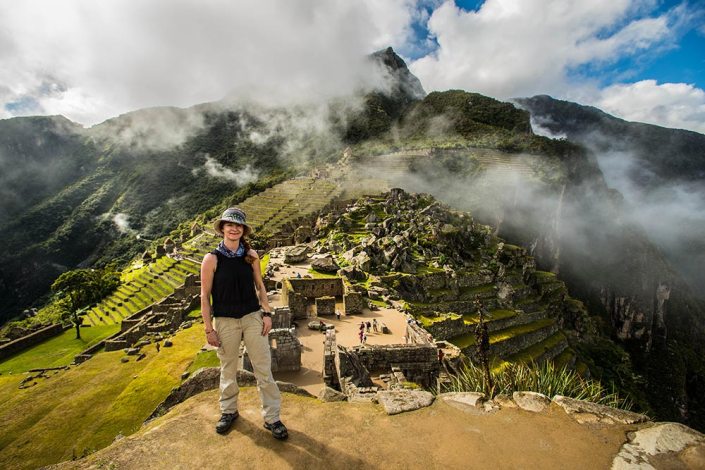
26-31 Jan 2015 – Bye Bye Bolivia, sea-sized Lake Titicaca & hello Peru!

Leaving La Paz wasn’t the cruisey ride I’d pictured. To begin with, we had some heartfelt farewells and heartwarming moto-hugs to dispense. Oscar reluctantly let us go and sent us on our merry way into the bedlam of downtown La Paz. Getting out of the city meant getting well and truly stuck in it first. Busy with barminess, I hovered over and hit my horn like I was signaling Morse code: ‘Get-me-out-of-here!’ A veritable racket and tantamount to ten times the danger of Bolivia’s disreputable Death Road. Sandwiched between Toyota Town-Aces and Hi-Aces, my panniers scraped and scratched like nobody’s business. A fit of fury stuck halfway down my throat, like a sneeze that refused to come. Mind unraveling to become somewhat discombobulated, I gritted my teeth and remained undeterred, at least outwardly.
Two and a quarter hours we trawled through rush hour in air that was oppressive, thick and full of menace. “Che boludo!”, I may’ve mouthed when drivers in their moving metal boxes pressed in; a derogatory term relating to the perpetrator’s derrière. “Breathe in Pearl”, I urged, “The nutters are out!” as sweat matted my riding top and motorcycle trousers to my arms and legs. I fidgeted like a toad leg frying in hot oil. Intermittently crawling through the city’s sprawl at a snail’s pace in between going hell for leather surfaced my inner-anarchist. Pearl was screaming out for idiot-protection bars like a four-wheel drive needs ‘roo bars in Australia’s bush. It was maddening as it was toilsome, I might as well have been treading in a flood of biting ants.
Would I miss the futile sense of urgency from drivers? – pipping in frantic haste whose clanging disorder and toxic fumes billowed around us – feeling the mixture wrap around my face like a hot bandage. The mishmash of concentrated blockhouses, built to look like a bland, Lego city and climbing up the rocky mesas like poison ivy. Or the trash-lined roads patrolled by snarling dogs that raced alongside us like whipped curs. That is, until becoming burnt out and bungled by malevolent forces – its guts slithered out like wet eels, sliding from a slit sack. The answer is probably not, cities are not ordinarily my thing. Sometimes the happiness of one end of a city can soon sour at the other. Jason was getting travel-weary of coursing through city after city; it was high time to leave them alone for a while.

Having finally escaped the brunt of La Paz’s stinging bite of traffic, an unforeseen reward for the morning’s calamity unfolded as we cruised towards Copacabana. Through a smog-blackened face, my eyes darted over rolling swells of green countryside on a stunning road. I smiled every mile past the traditional Aymará villages to the glacier-capped, brilliant white snowy peaks of the Cordillera Real. And then our eyes gravitated like magnets on the singularity of Lake Titicaca, its energy and sheer gravity drawing us in. Crystalline, gemlike water sparkled in a clear, Altiplano light. ‘Pretty special alright’, my radar registered.

No sooner had we kicked the side-stands down at San Pedro de Tiquina and the pair of us dived into the local catch. What felt like eating our head weight in fried white bait and trucha – trout, was a stomach-gratifying, taste sensation. That is, until the signal hit my brain I was more than full on fish. But what a welcomed interruption from meat.
Hopping across the water on a makeshift craft that resembled a rickety raft more than a sturdy boat was a rigmarole in itself, negotiating two heavy bikes aboard. The boat cleaved gently through turquoise waters until we spilled onto the shoreline. There we continued on ruta 2’s snaking ribbon of highway all the way to Copacabana – affording one of the best views of the vast expanse of blue. Biking bliss after the morning’s manic encounter with moronic drivers.

The world’s highest navigable body of water, Lake Titicaca is gar-gantuan. It goes on and on, way beyond the eye can see. A watery world without end. Set between Peru and Bolivia, the 8,400 square kilometre mass of shimmering freshwater is more akin to a sea than a lake. It’s no wonder history reveals how Inca legends and Andean beliefs came to credit Lake Titicaca with the birthplace of their civilization and the sun, connecting it to mystical events. There was a discernibly calm, soothing energy about the place.
Nestled between two hills and perched on the southern shore of the lake, Copacabana was a small, tourist-centric town, apparently still attracting international pilgrims who flock to its fiestas. We took flight after an overnight stay at Hostel Sonia having had our fill of Bolivia and pushed onto Peru.
Through Andean countryside dotted with villages, high-altitude hamlets and ruins all linked by ancient Inca culture, we sailed past terrace-lined foothills and mountainside. How had people once worked the land so industriously, so uniformly in linear lines – so high up? With women wearing petticoats and moccasins made from used tyres, still working the land by hand, it felt Peruvian all at once, rich in its Inca heritage.
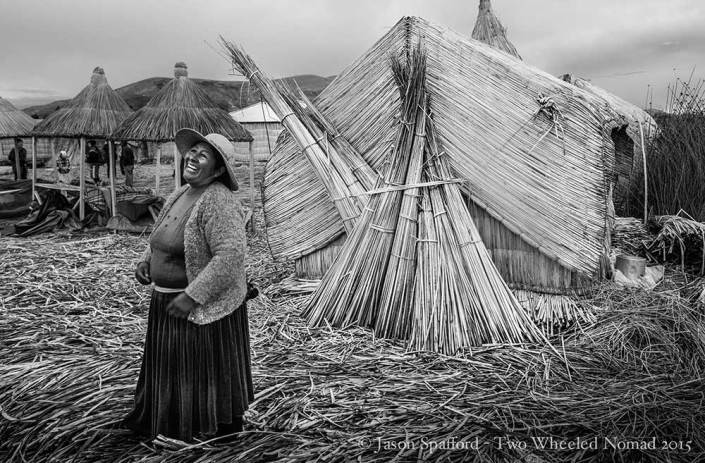
Just 7 kilometres east of our accommodation, Hostel Uros in Puno, we took ourselves off to see some floating islands. Utterly unique because they’ve been constructed from nothing; created entirely with the buoyant totora reeds that grow abundantly in the shallows of Lake Titicaca. The lives of the Aymará speaking Uros islanders are intertwined with the reeds. Edible in part, they also build their homes, transport, arts and whimsical crafts from the versatile material. Walking on the island was as soft and springy as a freshly baked cake. Their unusual floating existence roots back to an effort to avoid and isolate themselves from the aggressive Collas and Incas tribes. A peaceful people.

I was greeted by five families, all of whom displayed boundless personality. Although in tune with a tourist-ready set up, a set of folkloric songs were sung in dulcet tones of Aymará as well as a distant version of English. In such a contemporary age, I enjoyed seeing this time-honoured way of living for myself. Even if I did get further collared to pay for an obligatory reed-boat ride, powered by an engine attached to an adjoining smaller boat, and encouraged to buy handmade goods I was neither inclined to purchase nor wanted to carry on my motorcycle. These good folks needed to stay afloat like anyone else.
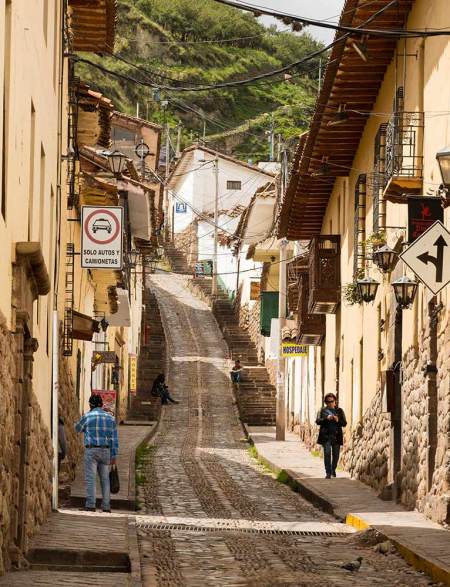
Cusco told me in ten minutes it would rank my favourite South American city to date. Rough-hewn cobble stoned, steep narrow streets, lined by meticulously crafted masonry and a bright, feel-safe city ambiance pervaded throughout. It was a superb collision of chaotic and modern with slow and traditional. Estrellita Hostel was an ideal spot for the bikes and us, closely located to the heart of the old-fashioned city. I cared little and less that the place was packed with massage hawkers, a glut of tourist ware-touting locals hunting you like prey amid a minefield of Machupicchu tour operators, the place was throbbing with life. The fare was excellent, especially the fresh cuisine at Jack’s Café and Korma Sutra. It was ‘vista fantastic’ with no shortage of intriguing vantage points. I could’ve sat people watching all day.
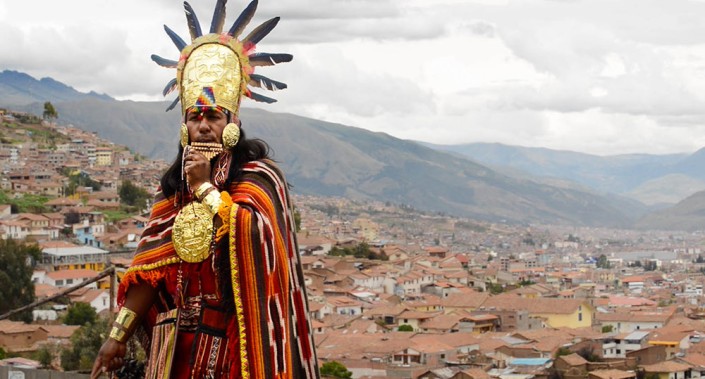

Fiestas occur at frequent intervals in Cusco and one night we meandered through a firework-lit celebration in honour of the church. Live festival-inspired music permeated our ears as I squeezed my way in between the carnival market vendors offering supersized pale corn-on-the-cob with cheese alongside chicha morada, which is a sweet Peruvian beverage made from purple corn, roasted guinea pig or alpaca. I soon became an inveterate fan to the cactus flower fruit, which was fuchsia pink and finger-licking good. In fact, Peru’s roads were full of the flowering fruits – bush food ripe for the picking and packed with a sweetened punch. It developed into the perfect roadside snack and our jam-sandwich breakfast substitute. People jostled past coming and going in the teeming streets; the place was alive with a street dancing atmosphere.

Courtesy of social media, we’d become acquainted with Andrew – a loquacious Brit with a passion for night skies, skippering boats and photography – who’d been living in Cusco for the last seven years. After three too many dark beers, we spotted a local singer being filmed half way up a scenic street. Jupiter’s moons were illuminating the sky and the singer’s crescent shape line of groupies were evidently enjoying the show. The situation fostered an odd behaviour. In the heat of a spontaneous second, I found myself shamelessly dancing with this cheesetastic grinning guy; perhaps not one of my classiest moments gatecrashing his gig! Still, the crowd eddied and purled around me, cheering with full encouragement exclaiming that I’d be sure to feature on Peruvian television. I haven’t the slightest inkling why doing that seemed a good idea at the time.
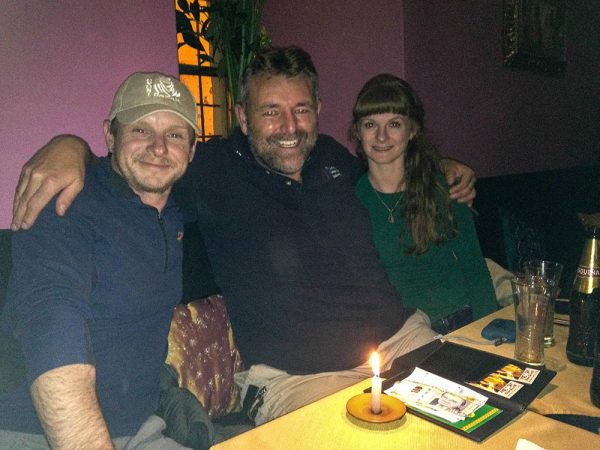

All walks of life can be found in Cusco, not just the holidaymakers, travellers, honorary locals and residents. A Peruvian woman, well into the winter of her days, sat kind of crouched over on the floor. In the middle of a busy backstreet. She may’ve fallen, dropped something or stooped to pick up something she’d found perhaps. “Are you alright lady? Can I help at all?”, I enquired in survival Spanish. Stumbling over the language I kept probing, like a tongue returning to an abscess. She looked at me a little strained and shook her head. I think I was walking on ground uninvited. Curious, I thought. Or not. I looked at a metre radius around the woman and the full force of recognition hit me. My quagmire was her irredeemable, sticky situation. This lady was patently and simply having a nice, big number two! I can’t speak with specificity about this lady’s choice of location but oh my, there’s a memory of Cusco that’ll never fade.


25 Jan 2015 – The Road of Death on motorcycle
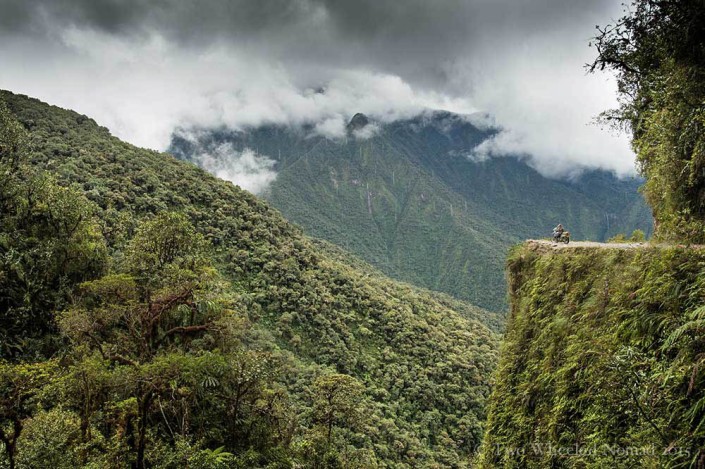
An 11,000-foot descent, sheer drops and 200 plus deaths a year: Welcome to Bolivia’s Road of Death, the terrifying route tourists love to two wheel down. Its official name is Camino a las Yungas but it’s best known as La Carretera de la Muerte, the Road of Death. It’s not just a name either: the gorgeously lush, winding 64-kilometre route that links La Paz with the town of Coroico was and is still considered one of the deadliest roads in the world. Just one of many in Bolivia.
The North Yungas journey is renowned to be overwhelming, as much for the staggering scenery as for the dangerous gravel route. Part of the transition zone where the Andes fall away into the Amazon Basin. For the locals, the ‘Death Road’ was an important transport route, which they braved in cars and trucks, teetering on the edge and risking their lives with every trip. The mortality rate is not surprising considering that: safety barriers are few and far between, vehicles meet head on along a miniscule dirt track – at peak altitudes of more than 4,500 metres – and with a vicious drop off on one side of up to 800 metres. No wonder it was deemed ‘The world’s most dangerous road’ by an Inter-American Development Bank report in 1995. On the up side there’s now a much improved, replacement route, which since 2007 tends to all the heavies and commuter traffic with far less incident than before. Still, leaving an old road not to be reckoned with.
Although still in use by the odd local car, tourist minibus and support vehicle, it’s the over-zealous cyclists that come a cropper, more than passing motorised traffic. This is because of kamikaze, freewheeling cycle guides racing down at full tilt for the sheer thrill, substandard mountain bikes on hire to one and all, or a blind unawareness if not overconfidence to any oncoming, upward traffic.

Psyched with a mixed bag feeling of ‘Just how hard is this road going to be?’ deliciously tinged with that pre-excitement you get moments before a rollercoaster’s tipping point. We gave ourselves no choice but to take a deep breath and carefully: navigate around careening cyclists hell bent on fulfilling their bragging rights, falling rocks and blind hairpin bends, penetrate waterfalls, cross two rivers and endure the fog, mud and humidity. All over a 3,600 metre vertical descent. We knew the trip was set to take in stunning views among the rolling hills, but come with the somewhat distracting – and for some frightening – lofty heights from the canopy as two rubber tyres separate the rider from a narrow single-lane road with very little in the way of roadside protection. The ride was set to be adrenaline-packed as it was unforgettable.
Built on the backbreaking labours of Paraguayan prisoners during the Chaco War between Bolivia and Paraguay, the construction of the road took place in the 1930s. Due to both the engineering design of that decade and the natural structure of the area, its topography and geological formation meant steep slopes were created. The resultant single-track lane varied in width from 2.9 to 3.5 metres.
Our starting point in La Paz at 3,600 metres was almost a low point compared to the motorcycle-chugging ascent up to La Cumbre’s cloud forest at 4,650 metres. Along the way on ruta 3, I coaxed Pearl on a little as she sighed in a sluggish, less responsive manner. ‘It’s alright lady, I’ll keep you in third gear’, I reassured her. We fumbled our way farther on through bike-swallowing fog under grey scraps of cloud, which tossed like leaves in a fitful breeze, shifted, like wind-tossed foliage. The cold wind helped to numb the pangs of hunger but didn’t alleviate my desperation for a pee; it pushed against my bladder like a pin piercing my belly.
With my visor permanently steamed up, icy rain pellets stung my cheeks as I carefully worked my way up and down the undulations of the road, skirting around deceptively deep potholes. I probably looked like a drunken sailor on two wheels heading toward the next watering hole. When you face the force of foggy rain, you don’t exactly ride boldly forward in a show of unbridled confidence. Bluster will get you battered. Still, the views passing Cotapata National Park took on the supremacy of the Scottish highlands, the delirium of England’s Lake District and then New Zealand’s soul-nourishing hills, towering above us. Bolivia for me just keeps getting better and better.
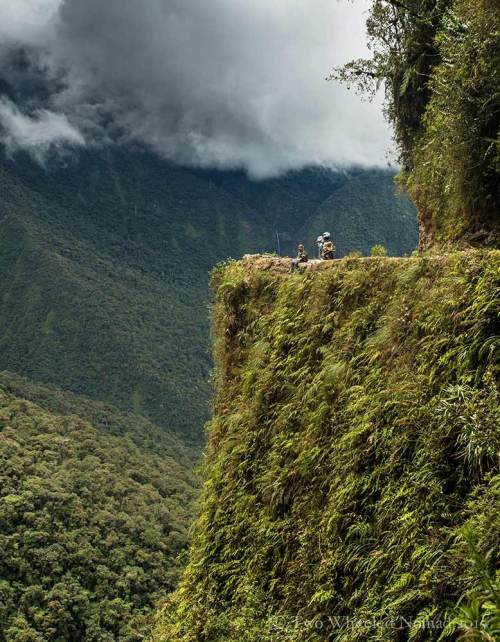 The entrance to the Death Road started in rarefied air, slightly above the already high-elevation of La Paz. Although not so deadly nowadays, for a few hummingbird heartbeats the realisation of making one mistake and you’d meet your maker hit home, but the thought flickered away again. May be the thought of reaching ‘game over’ had been lurking but I hadn’t dared to admit it because then, like the nuclear bomb, it could never be uninvented. Pearl and I would exercise care and become caution personified.
The entrance to the Death Road started in rarefied air, slightly above the already high-elevation of La Paz. Although not so deadly nowadays, for a few hummingbird heartbeats the realisation of making one mistake and you’d meet your maker hit home, but the thought flickered away again. May be the thought of reaching ‘game over’ had been lurking but I hadn’t dared to admit it because then, like the nuclear bomb, it could never be uninvented. Pearl and I would exercise care and become caution personified.
Before biting the bullet onto the road itself, we spotted a pair of 250cc Chinese bikes in a clearing and, perhaps stalling for a little time, headed straight for them. Two Australian guys were also preparing for the thrill ride, getting their gig in order as much mentally as physically. Their jacket-less armour and lightweight machines boasting proper knobblies made quite the model ‘Death Road’ ensemble. “Nice bikes, guys!” was the first comment to come from them. “Thanks lads, looking forward to the Death Road?” I enquired. Of course, now lets go do it.
The mix of beauty and danger on the Death Road was intoxicating. The stony dirt track thinned and when it nearly died altogether, grew more confident just as quickly, giving way to a wider track, which led to a stretch so to speak, rideable on road. Without wisdom, imagination is a cruel taskmaster. I observed early on that letting go of any alleviated gnaw of anxiety, got us moving much quicker.
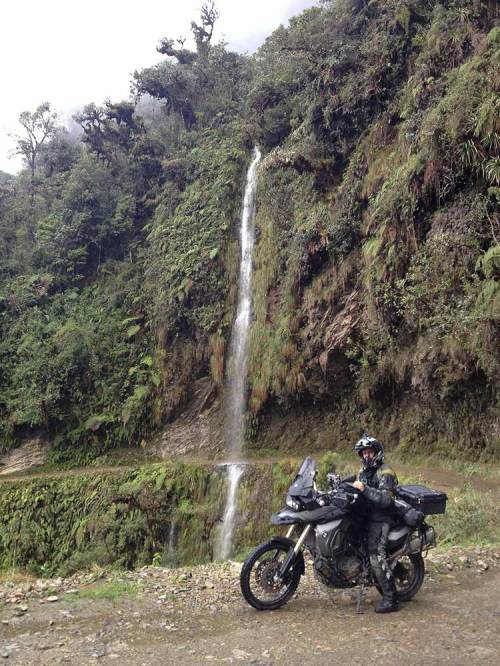
Despite the intermittent bounteous rainfall, repeatedly stopping to don and ditch the waterproof onesies, the weight of the world dissolved in the invigorating flashes of the rainbow-spraying waterfalls, the sun on my shoulders and the stillness of the place drawing me in. With the remnants of the cyclists remaining after midday – who waved their fronds and gave way to us – an excitement sang in my veins as I rode along the steep and bumpy track. It seemed the whole world was in my grasp, and it seemed as though I was lifting off above myself; tooling along on my Pearl and at the same time lifting into the sky, and so filled with elation and freedom that I had to open my mouth and scream.

Jason was itching like a kid on Christmas morning to unwrap the quadcopter from its box and take it for a spin over the near-vertical abyss. The space between the dry highlands’ Altiplano-bound clouds and the steaming, forested depths of the humid lowlands. I guess it’s every drone pilot’s dream to capture the airborne essence of such a dramatic scene. Alas, the pervading air of hard-won tranquility ceased and resulted in a rather calamity-led crash. Inches away from plummeting over the precipice, the unit dropped towards us like a gannet dive-bombing its prey. That high thin air left little and less for the drone to push against. Hey ho, Jason had still managed to shoot a few microseconds of aerial gold.
Hugging the walls of the sheer valley, we snaked our way beneath rocky overhangs and elongated cascades. It’s impossible to ignore the reminders of fatalities as we rode past shrines, memorials and crosses that pop up at chillingly frequent intervals. All marking the tragedy of the vast number of lives lost to the road. It humbled me from the inside out.
High in lush elevated jungle, riding through 100-meter high waterfalls, streams and by coca fields was a ride like no other. As I got power-showered through the waterfalls, the terrain became its most rocky. And slippery, washing away part of the road. I rallied. I had better go through with it, Pearl had pride. More than me. It was easier than I’d anticipated, as if I were an oyster already loosened within the shell. I held onto the little thrill this gave me. A needlelike pleasure in my stomach, just below my ribcage.

Close to the road’s connecting town of Coroico – a town that takes its name from the Quechua word coryguayco meaning ‘golden hill’ – we convened at the second river crossing. More rocky than the former river’s pebbly version, the latter was also longer; a 20-metre stream gushing water half way up our wheels as we wended through. Two locals had parked up in a shallower section, utilsing the free resource to clean their cars and themselves. Why not? The water looked fresh and sparkling, pure enough to drink I’d imagine. I staggered across on Pearl, a little jerky as Jason effortlessly glided through showing me how it was done. My textbook river crossing would have to wait.
We survived all the way to the end of the Death Road. Its steep mountains, plunging valleys and rugged terrain. Whoa! It seemed only logical to return the way we came and enjoy the road going back up. Even if it meant meeting the odd unsuspecting cyclist or car coming downhill; as oncoming upward traffic, we supposedly had right of way. Ascending was in fact easier, enjoying the physical and psychologically safer wall of the mountainside on my left. One of the few if not only places in South America that stipulates left-hand side driving.
The afternoon’s momentum maintained in full swing, showers fell on and off until eventually the sky dried and reared up above us, rose and lavender. The reverse journey saw long shadows inch across the dense, bottle green sub-tropical Yungas. There was a light from the sky that gilded the clouds, intensifying the sun lowering every hour. Definitely a day to let the world take care of itself, a paradise of thoughtfulness.

The Camino de la Muerte is a legendary road and despite its past innumerable deaths experienced, that moment of adrenaline, suspense to the unknown and exposure to nature, you can feel the fascination and buzz – down and up. Every second that passed the little hairs on the back of my neck rose, whilst my image-tank became full to bursting as emerging and radiant growth unfurled before us. It was a biker’s fantasy with jaw-on-the-floor views, another visceral experience. It left me windblown, mind blown and exhilarated.
